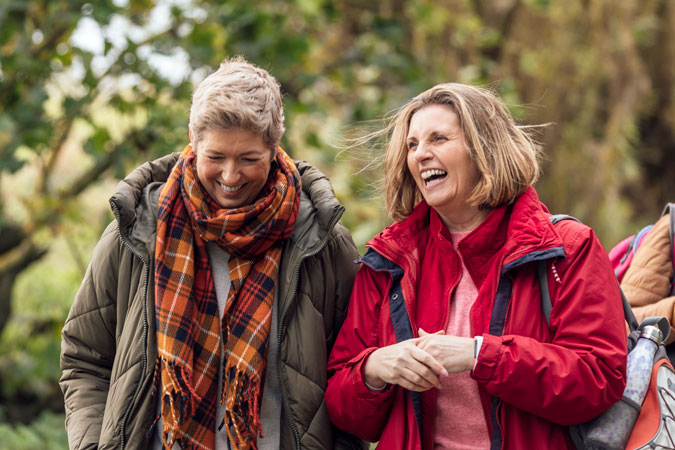Be physically active
Be physically active as part of everyday life – move more and sit less.

On this page
Overview of evidence
There is strong evidence that physical activity protects against cancers of the colon, breast (pre and postmenopausal), and endometrium.
There is also strong evidence that physical activity helps prevent excess weight gain and overweight and obesity, thereby indirectly contributing to a reduced risk of obesity-related cancers.
Goals
- Be at least moderately physically active and follow or exceed national guidelines
- Limit the time spent being sedentary (sitting or lying down)
Evidence
There is convincing evidence that physical activity (at moderate or vigorous intensity) DECREASES the risk of the following cancers:
- colon
- breast (postmenopausal )
- endometrium
There is probable evidence that physical activity (at a vigorous intensity) DECREASES the risk of:
- breast cancer (premenopausal).
Moderate intensity activities include walking, cycling, household chores, gardening, swimming, and dancing. Vigorous intensity activities include running, fast swimming, fast cycling, aerobics, lifting weights and team sports. 150 minutes of moderate exercise or 75 minutes of vigorous exercise is recommended per week (World Health Organisation, NHS, American Medical Association).
There is convincing evidence that walking protects against weight gain and overweight and obesity. There is also convincing evidence in children and probable evidence in adults that the more screen time (a marker of sedentary living) a person has the more likely they are to experience weight gain, as well as overweight and obesity. Greater body weight is a cause of many cancers, so physical activity indirectly reduces the risk of obesity-related cancers.
New technologies have encouraged people to increase the time they spend engaging in sedentary behaviours, such as watching television and using computers, electronic entertainment, and mobile phones.
As well as being sedentary, people watching screens are often exposed to intensive marketing of highly processed food and drink which are high in fat and/or sugar. They may also be more likely to consume energy-dense snacks and drinks while watching a screen compared with other activities.
Many occupations involve prolonged periods of sitting. Both adults and children should minimise the amount of time they are sedentary. Although evidence for sitting time as a risk for cancer (for example, endometrial cancer) and a determinant of weight is still emerging, it’s likely that extended periods of sitting may promote weight gain and so indirectly increase cancer risk.
Additional information
Other evidence on physical activity is limited (either in amount or because of issues with study design or other methodological flaws), but is suggestive of a decreased risk of oesophageal, lung and liver cancers.
In addition, there is evidence on sedentary behaviours that is limited but suggestive of an increased risk of endometrial cancer. Further research is required, and this limited evidence did not inform this recommendation.
Mechanisms
Physical activity affects several systems within the body including endocrinologic, immunologic and metabolic processes which can, in turn, influence the risk of developing various cancers. For example, exercise can decrease oxidative stress and enhance DNA repair mechanisms, potentially suppressing carcinogenesis.
Physically active individuals also tend to have higher sunlight exposure and consequently higher levels of vitamin D, which may modify cell proliferation.
Physical activity reduces body fatness and therefore has a beneficial effect on cancer risk, possibly through a reduction in insulin resistance and inflammation.
In colorectal cancer physical activity may also lower risk through stimulating digestion and reducing transit time through the intestine.
Exercise may affect breast cancer risk through its effects on insulin-like growth factors (IGFs) and through immunomodulatory effects which promote tumour surveillance.
Implications for other diseases
Regular physical activity of at least moderate intensity decreases the risk of all-cause mortality, coronary heart disease, high blood pressure, stroke, type 2 diabetes, metabolic syndrome and depression.
Regular weight-bearing and muscle-strengthening exercise promotes bone health and reduces blood pressure.
Public health / policy implications
In most parts of the world, levels of physical activity are insufficient for optimal health. A whole-of-government, whole-of-society approach is necessary to create environments for people and communities that are conducive to being a healthy weight and consistent with our Cancer Prevention Recommendations.
A comprehensive package of policies is needed to promote and support physical activity. Our Policy blueprint for cancer prevention and Physical activity and cancer prevention factsheet outline all the policy areas where governments must take action to create a healthy environment. This includes policies that influence the built environment, promote active travel or those that promote physical activity in healthcare settings.
These policies can also help contribute to a sustainable ecological environment. Policymakers are encouraged to frame specific goals and actions according to their national context.
Further reading
Get more detail on this topic from different parts of our Diet and Cancer Report 2018


